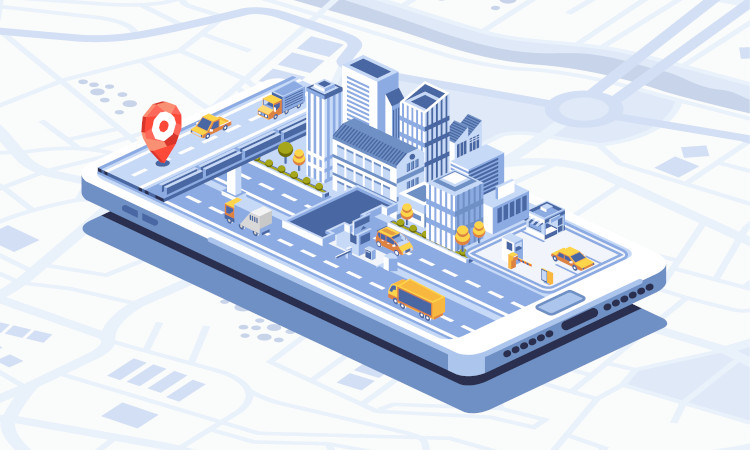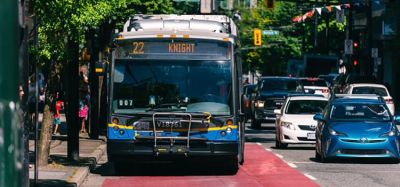The challenges of sustainability and integration in urban mobility
- Like
- Digg
- Del
- Tumblr
- VKontakte
- Buffer
- Love This
- Odnoklassniki
- Meneame
- Blogger
- Amazon
- Yahoo Mail
- Gmail
- AOL
- Newsvine
- HackerNews
- Evernote
- MySpace
- Mail.ru
- Viadeo
- Line
- Comments
- Yummly
- SMS
- Viber
- Telegram
- Subscribe
- Skype
- Facebook Messenger
- Kakao
- LiveJournal
- Yammer
- Edgar
- Fintel
- Mix
- Instapaper
- Copy Link
Posted: 9 December 2020 | Julian Renninger - SBB, Luisa Wahlig - HERE | No comments yet
Luisa Wahlig at HERE Technologies and Julian Renninger from SBB talk to Intelligent Transport about intermodal urban mobility and the urgency of addressing sustainability and integration within it.


When and why do people choose to travel using intermodal services? When does it makes sense for them to do so and in which circumstances does it makes sense for operators and authorities to provide those services?
Julian Renninger: There are many people who are already used to travelling using intermodal services – they just don’t label it as such. Someone using their own bike to travel between train stations or from a train station to a tram stop is taking an intermodal journey, for example. Mobility operators see intermodal travel as a broader concept where people are willing to use different modes of transport and interchange between them routinely as they would between trams and buses.
Different to the world of today, where we often just look at timetables and routings for the fastest options, suddenly the convenient options and options that consider personal preferences are much stronger; people like to take intermodal routes when it feels good for them. As an operator, we would like to see people take more intermodal routes as a way to help tackle two problems: ease of access to public transport and managing low-capacity, low-frequency services.
For this first challenge, especially for remote areas, something like a park and ride would make public transport a part of an intermodal journey and more accessible. For the second issue, we should not continue offering night bus services if only one or two people are using them, but instead offer options like e-scooters or car-sharing. These might then take you to a train or bus that has better occupancy and run better because we’re better able to manage them.
Luisa Wahlig: People that follow habits or patterns, meaning they know exactly how to get from A to B whether intermodally or not – do they really need technology? I would argue they don’t. What we’re seeing with the hype around Mobility as a Service, and the emergence of so many new options, is more spontaneous trips that could be disrupted because of traffic or a service not running. Especially against the backdrop of COVID-19, people feel very uncertain all of a sudden about their usual travel habits.
Ultimately, technology in these instances is about getting information to the consumer and giving them more transparent information. This is where intermodal routing and technology really makes sense, but for those that know exactly how to get from A to B, we don’t really need technology. People will only follow this steering and consider changing their travel behaviour if it’s easy and convenient to do so – they won’t do it if they have to download an additional app because it creates friction where they want simplicity. Integration and seamlessness, to mention a few buzzwords, are absolutely critical – and this is also where technology can play a role again.
To pick up on Julian’s last point, I think the one aspect to all of this that we’re still right at the beginning of is the entire operation and network behind it. This is not something that you can solve with an app. It doesn’t make sense to run a large bus in off-peak times at night, connecting urban and suburban areas if no one needs that connection at that time. Bringing this back to the need for integrated networks, what we currently have is fixed-route public transport that runs pretty much in isolation away from other urban mobility services, which are then also run in isolation in their own way. If we really want to provide multimodal services that are more convenient, faster and cheaper, these operational networks need to be much better integrated.
This is probably the hardest part because it requires infrastructure providers, mobility service operators and authorities to come together and find common ground.
People that follow habits or patterns, meaning they know exactly how to get from A to B whether intermodally or not – do they really need technology?”
Julian Renninger: I think this vision we have of interconnected mobility is amazing, but there’s a long way to go. Luisa is right in saying that you don’t solve this problem with an app.
There’s too often a feeling right now that if you develop an app and open the access to everyone, it will work; I’m convinced it won’t. We really have to work together on this, but the examples are few and far between. We’re still seeing mistrust between the governmental organisations and service providers like SBB. I have the feeling we are much further away from the vision than we actually think we are.
Luisa Wahlig: There is a long way to go, but the situation is reflected differently around the world – it might be much easier in Asia and in the Americas. In Europe, we have such a dramatic level of fragmentation. We have strong role public transportation, which I think can be a huge benefit and advantage, but for now, it’s just slowing down progress. It’s really hard to find a level playing field and full cooperation between all the players in the European mobility market.
There’s too often a feeling right now that if you develop an app and open the access to everyone, it will work; I’m convinced it won’t”
Julian Renninger: At SBB, our future plans are looking to what the horizon will look like in 40 years, and all of the tech companies and start-ups that are changing mobility aren’t thinking further ahead than three years. If we really want to change the way we move, we have to build different infrastructure, but the infrastructure we’re living with now was planned 40 years ago. There are these very impatient tech start-ups trying to build apps and change the world now, and these established, strong governmental organisations thinking, “Let’s see in 40 years”.
Luisa Wahlig: I think the unit economics are a bit different, too. If you’re a tech company, it’s a race for scale – you aim for user base. In the public sector, it’s about respecting this criterion of sustainability, of accessibility, of reliability. The metrics for each model are completely different.
Reshaping the way we plan and move: Making urban mobility more accessible and sustainable, together
Hear more from Luisa Wahlig and Julian Renninger in our on-demand webinar, as they discuss current challenges from a public transport operator’s and city planner’s perspective, and how location technology can play a vital role in shaping future-proof transport services.
What do you anticipate the long-lasting changes to the sector will be after COVID-19? What does the data we have available tell us about this, and what kind of predictions can we make from it?
Luisa Wahlig: I think what we can all see is the dramatic short-term impact; if you analyse the data, you see a sharp decline in overall mobility during the first lockdowns around Europe. After this period, you see a fairly sharp recovery of private car usage along with a sharp increase of bicycle traffic. We’re also seeing this echoed by authorities or cities reallocating space to bicycle lanes.
We also saw a steep decline in public transportation usage, but this is a much slower recovery. The explanation for this is social distancing and a fear of crowding with other people. Whether this will be the case in the long term is really difficult to predict. I think we’re seeing some macro trends here linked to flexible working; we have all seen the announcements from big companies that basically say they will not re-introduce office work as mandatory moving forwards. That flexibility means there will be much more flexibility in the kind of traffic flows and levels that would usually be seen at peak times.
Personally, I think this trend will last, but I also see this as an opportunity for transportation to balance the load a bit better.
Julian Renninger: I think in the short term, you really don’t want to be a manager in these public transport companies! The only thing we can do is save money and kill projects. In normal circumstances, people are open to taking a train and not buying a car – now, people are noticing that the freedom of their own car is quite a wonderful thing, but the moment they invest into their own car, we lost them.
I think public transport companies are more scared of these long-term effects, especially when it comes to their young passengers. Personally, I can’t drive a car, but now I’m learning and that shows the effect of the situation. As Luisa says, there is opportunity too; I think in some areas pre-pandemic, trains and buses were too full, so maybe we use this period to really think about the concept of the future and what the requirements are going to be.
How dramatically do you think the uptick in car traffic during the pandemic is going to affect sustainability and shared mobility uptake moving forward?
Luisa Wahlig: Personally, I believe that sustainability is a more dominant trend in comparison to COVID-19 and social distancing. We choose to travel in a certain way on a broader scale. Collaboratively, I think we need to discuss is where to start with conversations on sustainability. Infrastructure can incentivise bicycle usage, public transit schedules can be more flexible and demand responsive – but is there another way?
It’s about incentivising people to be more sustainable.”
I think that companies and corporates have a big responsibility here. There are still way too many company cars out there. Looking at Germany, for example, a vast amount of new car sales come from company cars. This might be a good place to start because it’s an area where politics can have a greater influence over private purchasing behaviour.
It’s about incentivising people to be more sustainable. If we’re looking at today’s apps, we can maybe look at gamification to change consumer behaviour. For example, show people their CO2 footprint and the impact of each journey on it, while also suggesting new ways of making that trip in a more sustainable way.
When we talk about sustainability, there’s a lot of focus on what it means for mobility to be green and shared, but what about our cities and their infrastructure? How do we organise the mobility of the future and what is it going to look like when you take into consideration public transport, new mobility services, and the integration of those into what is almost a deregulated market in places?
Luisa Wahlig: I’d say we’re still learning and it’s probably too early to say. Cities have had their first experiences of that process now and have a better understanding of the impacts of that deregulated market. Europe chose to wait and see and is now further behind, but has the opportunity to learn from the mistakes of others.
The obvious question is who should orchestrate these transport services and networks? If we look at it on a much broader scale away from transportation, considering citizens’ wellbeing and liveable cities, I think it’s clear that there needs to be very close public and private partnerships, but with the public sector driving the agenda and setting objectives. Otherwise, we risk contradicting the goals of sustainability and accessibility in the long term.
Julian Renninger: I agree completely. Speaking personally about my own government, I notice that they’re absolutely aware of these trends and they know that they have to play a role, but I have the feeling they don’t know how. The Swiss government has ordered an open data platform for shared vehicles and would also like to offer open data or open source intermodal routing, but they’re just using the buzzwords. They know that they have to orchestrate this somehow, but they’re missing the tools to really develop the knowledge on how it works. Their approach is too administrative and they must take a more active role.
I hope the government does manage to take an active role. I like the public-private partnership approach and I hope that companies like HERE and SBB can help the government to form its idea of how mobility should be so they can set the right goals.
I still feel there’s a lot of mistrust between parties, though. This orchestrating of mobility is highly political and there’s fear with regards to all these platform effects; you don’t want to have Facebook or Google organising mobility for the whole of Europe. You want to be able to set your own goals, your own culture, and how your own country is functioning.
It’s natural to be apprehensive about these over-powered tech companies and platforms, but you can’t do it on your own. There’s a data literacy gap between the public and private sectors that needs to close.








